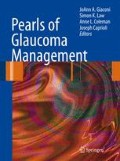Abstract
Before looking at an HRT printout, it is important to understand why the test was ordered. The HRT has two roles in practice, first to assist the clinician in diagnosing glaucoma and second to assist the clinician in identifying glaucomatous progression. The current HRT 3 software can generate eight different printouts (Table 3.1), two of which (“trend report” and “TCA overview”) summarize progression algorithms; these will be discussed in question 3.3. The remaining six printouts (“minimal report,” “Moorfields report,” “OU Quickview Report,” “OU Report,” “Stereometric Report,” and “Stereometric with Moorfields Report”) summarize data from a single scan (in the case of OU reports – from both eyes) and should be used to help the clinician decide whether or not features of the optic nerve head (ONH) are suggestive of glaucomatous optic neuropathy. Information from HRT printouts alone will not be sufficient to make a diagnosis of glaucoma; this requires interpretation of the results in the context of patient history, clinical examination, and perimetry findings.
Access this chapter
Tax calculation will be finalised at checkout
Purchases are for personal use only
References
Ferreras A, Pablo LE, Larrosa JM, et al Discriminating between normal and glaucoma-damaged eyes with the Heidelberg retina tomograph 3. Ophthalmology 2008;115:775–81.
Coops A, Henson DB, Kwartz AJ, Artes PH. Automated analysis of Heidelberg retina tomograph optic disc images by glaucoma probability score. Invest Ophthalmol Vis Sci 2006;47(12):5348–55.
Zangwill LM, Jain S, Racette L, et al The effect of disc size and severity of disease on the diagnostic accuracy of the Heidelberg Retina Tomograph Glaucoma Probability Score. Invest Ophthalmol Vis Sci 2007;48(6):2653–60.
Strouthidis NG, White ET, Owen VM, et al Factors affecting the test-retest variability of Heidelberg retina tomograph and Heidelberg retina tomograph II measurements. Br J Ophthalmol 2005;89(11):1427–32.
Strouthidis NG, White ET, Owen VM, et al Improving the repeatability of Heidelberg retina tomograph and Heidelberg retina tomograph II rim area measurements. Br J Ophthalmol 2005;89(11):1433–7.
Tan JC, Garway-Heath DF, Hitchings RA. Variability across the optic nerve head in scanning laser tomography. Br J Ophthalmol 2003;87(5):557–9.
Tan JC, White E, Poinoosawmy D, Hitchings RA. Validity of rim area measurements by different reference planes. J Glaucoma 2004;13(3):245–50.
British Standards Institution. Precision of test methods I: Guide for the determination and reproducibility for a standard test method, vol. BS 5497, part 1. London: BSI, 1979.
Fayers T, Strouthidis NG, Garway-Heath DF. Monitoring glaucomatous progression using a novel Heidelberg retina tomograph event analysis. Ophthalmology 2007;114(11):1973–80.
Chauhan BC, Blanchard JW, Hamilton DC, LeBlanc RP. Technique for detecting serial topographic changes in the optic disc and peripapillary retina using scanning laser tomography. Invest Ophthalmol Vis Sci 2000;41(3):775–82.
Strouthidis NG, Scott A, Peter NM, Garway-Heath DF. Optic disc and visual field progression in ocular hypertensive subjects: detection rates, specificity, and agreement. Invest Ophthalmol Vis Sci 2006;47(7):2904–10.
Patterson AJ, Garway-Heath DF, Strouthidis NG, Crabb DP. A new statistical approach for quantifying change in series of retinal and optic nerve head topography images. Invest Ophthalmol Vis Sci 2005;46(5):1659–67.
Garway-Heath DF, Friedman DS. How should results from clinical tests be integrated into the diagnostic process? Ophthalmology 2006;113(9):1479–80.
Kourkoutas D, Buys YM, Flanagan JG, et al Comparison of glaucoma progression evaluated with Heidelberg retina tomograph II versus optic nerve head stereophotographs. Can J Ophthalmol 2007;42(1):82–8.
Author information
Authors and Affiliations
Corresponding author
Editor information
Editors and Affiliations
Rights and permissions
Copyright information
© 2010 Springer-Verlag Berlin Heidelberg
About this chapter
Cite this chapter
Strouthidis, N.G., Garway-Heath, D.F. (2010). Optic Nerve: Heidelberg Retinal Tomography. In: Giaconi, J., Law, S., Coleman, A., Caprioli, J. (eds) Pearls of Glaucoma Management. Springer, Berlin, Heidelberg. https://doi.org/10.1007/978-3-540-68240-0_3
Download citation
DOI: https://doi.org/10.1007/978-3-540-68240-0_3
Published:
Publisher Name: Springer, Berlin, Heidelberg
Print ISBN: 978-3-540-68238-7
Online ISBN: 978-3-540-68240-0
eBook Packages: MedicineMedicine (R0)

